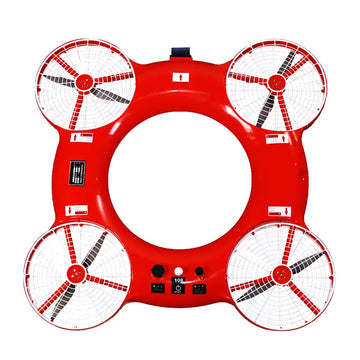In today’s fast-paced world, every second counts when it comes to emergency water rescues. With drowning incidents remaining one of the leading causes of accidental deaths worldwide, technology has stepped in with an innovative solution: the lifebuoy drone. This cutting-edge piece of rescue equipment is not only changing the dynamics of water rescue operations but also setting a new standard for safety and efficiency.
What is a Lifebuoy Drone?
The lifebuoy drone is a specialized unmanned aerial vehicle (UAV) designed specifically for water rescue missions. Unlike traditional rescue methods that rely on boats and human intervention alone, this drone is equipped with an integrated flotation device—essentially transforming it into a flying lifebuoy. This dual functionality makes it a powerful tool in emergencies, particularly in areas where rapid response is crucial.
Key Features:
-
Integrated Flotation Device: The drone is engineered to transform into a life-saving buoy the moment it reaches a distressed individual in the water.
-
Remote Control and GPS Navigation: With advanced GPS systems and a remote control interface, operators can quickly and accurately locate individuals in distress and deploy the lifebuoy instantly.
-
All-Weather Operation: Designed to perform in a variety of weather conditions, the lifebuoy drone can take off and land on water surfaces repeatedly, ensuring a rapid response regardless of environmental challenges.
-
High Speed and Agility: Capable of reaching speeds up to 46.8 km/h, the drone minimizes response times, increasing the chance of a successful rescue.
How Does the Lifebuoy Drone Enhance Rescue Operations?
Speed: The Critical Factor in Water Rescue
In water rescue, time is of the essence. The moment someone falls into the water, the clock starts ticking. Traditional rescue methods can often be slow, especially in rough weather or challenging terrains. The lifebuoy drone bridges this gap by drastically reducing the response time. Its ability to quickly locate and reach a victim allows rescue teams to dispatch boats or other aid more effectively.
Safety: Protecting Both Victims and Rescuers
Rescue missions are inherently dangerous, with rescuers often putting their lives at risk. The lifebuoy drone significantly reduces this risk by handling the initial contact with the victim. Once the drone reaches the person in distress, it deploys its flotation device, providing immediate buoyancy and stabilizing the individual until additional help arrives. This not only protects the victim but also minimizes the exposure of rescue personnel to hazardous conditions.
Precision: The Role of Advanced Technology
Utilizing GPS navigation and a high-resolution camera, the lifebuoy drone ensures pinpoint accuracy in identifying and reaching the target area. The drone’s camera relays real-time footage back to the operator, who can monitor the situation and make informed decisions about the best course of action. This technological advantage ensures that every second is maximized during rescue operations.
The Technology Behind the Lifebuoy Drone
The success of the lifebuoy drone is built on a foundation of robust technology and innovative design. Here are some of the technical aspects that make it a game-changer:
Integrated Flotation and Impact Resistance
One of the standout features of this drone is its integrated flotation system, designed to offer a buoyancy force of up to 190N. This means that even in turbulent waters, the drone can maintain stability and perform its lifesaving role. Additionally, the drone is built with materials that meet high-impact resistance standards, ensuring that it remains operational even after multiple water landings.
IP68 Waterproof Rating
Water rescue drones must be able to withstand harsh water conditions. With an IP68 waterproof rating, the lifebuoy drone is designed to operate in up to 1.5 meters of water for prolonged periods. This rating ensures that the internal electronics are fully protected against water ingress, providing reliable performance in critical situations.
Dual-Adult Operation Capability
Rescue scenarios can be unpredictable, which is why the lifebuoy drone is engineered to support the weight of two adults simultaneously. This feature is particularly beneficial in mass rescue situations where multiple individuals require immediate assistance.
Advanced Flight Control and Stability
For any rescue operation, stability during flight is paramount. The drone’s flight control system is designed to maintain a stationary hover within a precise 1.6-meter range. This precision is essential when deploying the lifebuoy and ensuring that it lands accurately next to the victim.
Global Impact: Changing the Face of Water Rescue
The introduction of the lifebuoy drone is set to disrupt the traditional methods of water rescue. Developed by innovative companies like DIDIOK MAKINGS, this technology has not only been successfully mass-produced but is also being exported to international markets. Its global impact is evident in several ways:
Subverting Traditional Rescue Methods
By integrating advanced drone technology with lifesaving equipment, the lifebuoy drone completely subverts traditional water rescue models. No longer are rescuers solely dependent on boats and human intervention; instead, they can now deploy a rapid, remote-controlled solution that reaches victims faster than ever before.
Enhancing Rescue Operations in Diverse Environments
From open seas to inland lakes and even tourist hotspots, water rescue scenarios vary widely. The lifebuoy drone is adaptable enough to handle these diverse environments, making it an essential asset for maritime rescue operations worldwide. Its ability to operate in various weather conditions and rough waters expands the scope and effectiveness of rescue missions.
A Technological Leap Forward
The successful implementation of the lifebuoy drone is a testament to the leaps made in drone technology and rescue operations. It represents a significant advancement in how emergencies are managed, showcasing the potential of combining technology with humanitarian efforts to save lives.
Future Prospects of Lifebuoy Drone Technology
As we look to the future, the potential for lifebuoy drone technology continues to grow. Ongoing research and development are expected to further enhance the capabilities of these drones, with innovations such as:
-
Improved Battery Life: Extending flight duration to cover larger rescue areas.
-
Enhanced Sensor Integration: Incorporating thermal imaging and additional sensors for even better victim detection.
-
AI-Powered Navigation: Utilizing artificial intelligence to predict and respond to rescue scenarios faster and more accurately.
The continuous evolution of this technology promises not only to increase the success rate of rescue missions but also to inspire further innovations in the field of emergency response.
Conclusion
The lifebuoy drone is more than just a piece of technology—it is a lifeline that bridges the gap between life and death in critical water rescue scenarios. By combining rapid response, precise navigation, and unparalleled safety features, this innovative drone is setting new standards in rescue operations worldwide.
For emergency response teams, government agencies, and humanitarian organizations, the lifebuoy drone offers a revolutionary approach to saving lives, ensuring that every second counts. As this technology continues to evolve, we can look forward to a future where water rescue operations are safer, faster, and more effective than ever before.
Embrace the future of water rescue—embrace the lifebuoy drone.
By integrating advanced drone technology with lifesaving capabilities, the lifebuoy drone is truly a game-changer in water rescue operations. Stay tuned for more updates on how technology is reshaping the future of emergency response.





